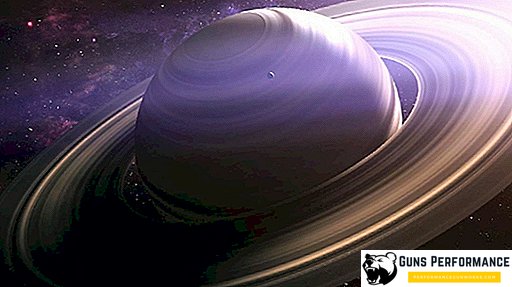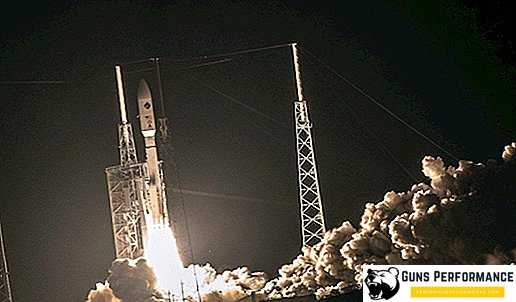In our solar system there is a mass of amazing space objects, the interest in which is not waning. One of these objects is Saturn - the sixth planet of the solar system, the most amazing and unusual celestial body located in the closest space to us. The huge size, the presence of miraculous rings, other interesting facts and features that the sixth planet has, make it the object of close attention of astrophysicists.

Discovery of the ringed planet
Saturn, like its neighbor, the huge Jupiter, is one of the largest objects in the solar system. The first information about a beautiful planet man began to collect in the era of ancient civilizations. The Egyptians, Persians and the ancient Greeks personified Saturn with the supreme deity, imparting a yellowish star on the night sky with mystical power. The ancients attached great importance to this planet, creating and shaping the first calendars on it.

In the era of ancient Rome, the worship of Saturn reached its apogee, marking the beginning of Saturnalia - the festivals of agriculture. Over time, the worship of Saturn became a whole direction in the culture of the ancient Romans.
The first scientific facts about the planet Saturn fall at the end of the XVI century. That is the great merit of Galileo Galilei. It was he who, for the first time with the help of his imperfect telescope, placed Saturn among the objects of our solar system. The only thing that failed to glorified astronomer, so it is to detect the charming rings of the planet. The decoration of the planet in the form of huge rings, with diameters of three, four times the diameter of the planet itself, was discovered in 1610 by the Dutch astrophysicist Christian Huygens.
Only in the modern era, when more powerful ground-based telescopes appeared, did the scientific community manage to fully examine wonderful rings and discover other interesting facts about the planet Saturn.
A brief excursion into the history of the planet
The sixth planet of the solar system is among the same gas giants as Jupiter, Uranus and Neptune. Unlike the terrestrial planets of Mercury, Venus, Earth and Mars, these are real giants, celestial bodies of enormous dimensions of gaseous structure. Not without reason, scientists consider Saturn and Jupiter to be related planets, with a similar atmosphere and astrophysical parameters.

Due to its environment, represented by a whole cohort of large and small satellites, huge and bright rings, the planet is considered the most recognizable in the solar system. However, despite this, this planet is the least studied. The description of the planet today comes down to ordinary and mean static data, including dimensions, mass, and density of a celestial body. No less scant information about the composition of the planet’s atmosphere and its geomagnetic field. The surface of Saturn, hidden by dense gas clouds, is generally considered to be a dark spot for astrophysicists in science.
What do we know about Saturn today? In the night sky, this planet appears quite often and is a bright star of a pale yellow color. During the confrontations, this celestial body looks like a star with a brightness of 0.2-0.3 m of magnitude.

The relatively high brightness of the planet is most likely due to the large size of the planet. Saturn has a diameter of 116,464 thousand km, which is 9.5 times more than the parameters of the Earth. A ringed giant looks like an egg stretched at the poles and flattened in the equatorial region. The average radius of the planet is just over 58 thousand km. Together with the rings, the diameter of Saturn is 270 thousand km. The mass is 568,360,000 trillion kg.
Saturn is 95 times heavier than Earth and is the second largest space object in the solar system after Jupiter. At the same time, the density of this monster is only 0.687 g / cm3. For comparison, the density of our blue planet is 5.51 g / cm ³. In other words, a huge gas planet is lighter than water, and if you put Saturn in a huge pool of water, it would remain on the surface.
Saturn has an area of over 42 billion square meters. kilometers, exceeding the surface area of 87 times. The volume of the gas giant is 827.13 trillion. cubic kilometers.
Curious data of the orbital position of the planet. Saturn is 10 times farther from the Sun than our planet. Sunlight reaches the surface of a ringed planet in 1 hour and 20 minutes. The orbit has the third largest eccentricity, second only to Mercury and Mars in this indicator. The orbit of the planet is distinguished by a slight difference between aphelion and perihelion, which is 1.54 x 108 km. Maximum Saturn is removed from the Sun at a distance of 1513 783 km. The minimum distance of Saturn from the Sun is 1353600 km.

The astrophysical characteristics of the planet in comparison with other celestial objects of the solar system are quite interesting. The orbital speed of the planet is 9.6 km / s. A complete revolution around our central luminary takes Saturn less than 30 years. The speed of rotation of the planet around its own axis is significantly higher than that of the Earth. The turnover of Saturn around its own axis can be 10 hours and 33 minutes, versus 24 hours for our world. In other words, the Saturnian day is much shorter than the earthly one, but a year on a ringed planet will last as many as 24,491 Earth days. The nearest planets to Saturn - Jupiter and Uranus - rotate around their own axis much slower.
A characteristic feature of the position of the planet and the speed of rotation around its own axis is the presence of changes of seasons. The axis of rotation of the ringed giant is inclined to the orbital plane at the same angle as the Earth. Seasons are also present on Saturn, only they last much longer: spring, summer, autumn and winter stretch on Saturn for almost 7 years.
The giant is located on Earth at an average distance of 1.28 billion kilometers. In times of confrontation, Saturn is closest to our world at a distance of 1.20 billion kilometers.

With such huge distances, it will take a long time to fly to the ringed gas giant with the current technical capabilities. The first automatic probe "Pioneer-11" flew to Saturn for more than 6 years. Another space wanderer, the Voyager-1 probe, traveled to the gas giant for over 3 years. The most famous spacecraft "Cassini" flew to Saturn for 7 years. The latest achievement of humanity in the study and exploration of outer space in the Saturn area was the flight of the automatic probe “New Horizons”. This unit reached the area of rings after 2 years and 4 months from the day of launch at Cape Canaveral launch site.
Characteristics and composition of the atmosphere of the planet
By its structure, the second largest planet of the solar system is very similar to Jupiter. The gas giant consists of three layers. The first, innermost layer is a dense massive core consisting of silicates and metal. In terms of mass, the core of Saturn is 20 times heavier than our planet. The temperature in the center of the core reaches 10-11 thousand degrees Celsius. This is due to the tremendous pressure in the inner regions of the planet, which reaches 3 million atmospheres. The combination of high temperature and enormous pressure leads to the fact that the planet itself is capable of radiating energy into the surrounding space. Saturn gives 2.5 times more energy than it receives from our star.

Scientists believe that the diameter of the core is 25 thousand kilometers. If you climb higher, after the core begins a layer of metallic hydrogen. Its thickness varies between 30 and 40 thousand km. Behind the layer of metallic hydrogen begins the uppermost layer, the so-called surface of the planet, filled with hydrogen and helium in a semi-liquid state. The layer of molecular hydrogen on Saturn is only 12 thousand km. Like other gas planets in the solar system, Saturn does not have a clear boundary between the atmosphere and the surface of the planet. A huge amount of hydrogen creates an intense circulation of electric currents, which, together with the magnetic axis of the planet, form the magnetic field of Saturn. It should be noted that the magnetic shell of Saturn is inferior in its strength to the magnetic field of Jupiter.

According to the composition of the atmosphere, the sixth planet of the solar system is 96% composed of hydrogen. Only 4% comes from helium. The thickness of the atmospheric layer on Saturn is only 60 km, but the main feature of the Saturnian atmosphere is different. High speed of rotation of the planet around its own axis and the presence in the atmosphere of a huge amount of hydrogen causes the separation of the gas envelope into stripes. Clouds also mainly consist of molecular hydrogen diluted with methane and helium. High speed of rotation of the planet contributes to the formation of stripes that look thinner in the polar regions and significantly expanding, approaching the equator of the planet.
Scientists believe that the presence of bands in the Saturnian atmosphere indicates a high rate of movement of gas masses. On this planet the strongest winds blow in the entire solar system. According to data obtained from the board of "Cassini", the wind speed in the atmosphere of Saturn reaches 1800 km / h.
The rings of Saturn and its satellites
The most remarkable object in terms of studying the sixth planet of the solar system are its rings. Saturn's moons are of no less interest because of their huge size and the presence of a solid surface.

The gas giant's rings are a huge cluster of space debris that has accumulated in areas of Saturn over many billions of years. Ice and stone fragments of cosmic matter form 7 large rings of different widths, separated by 4 slits. All rings of Saturn were designated in Latin letters: A, B, C, D, E, F and G. The slots have the following names:
- Maxwell's crack;
- shel Cassini;
- Enkea slot;
- Killer's crack.
Due to the presence in the structure of the rings of a huge amount of cosmic ice, these formations are clearly visible in a powerful telescope. Armed with Go-To telescopes from the earth, you can observe only the two largest rings of Saturn.

As for the satellites of Saturn, then this gas giant has no competitors among the currently known celestial bodies. Officially, the planet has 62 satellites, among which the largest objects stand out. The second largest natural satellite in the Solar System, Titan, which is larger than the planet Mercury, has a diameter of 5150 km. and exceeds its size Mercury. Unlike its owner, Titan has a dense nitrogen atmosphere.

However, it is not Titan that interests scientists today. The sixth largest satellite of Saturn, Enceladus, was a celestial body, on the surface of which traces of water were found. This fact was first discovered by Hubble images and confirmed by the flight of the Cassini space probe. On Enceladus gushing geysers were discovered, extensive arrays of surface covered with a layer of ice. The presence of water in the geological structure of this satellite suggests scientists the idea that the solar system may have other forms of life.












